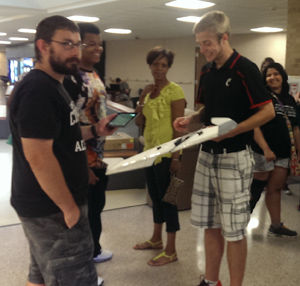Jun 9 2014
Kelly Cohen, PhD and associate professor in the UC College of Engineering and Applied Science (CEAS) Department of Aerospace Engineering and Engineering Mechanics, recently used an Ohio Space Grant Consortium (OSGC) Mini-Grant to host the “Flight Camp at the University of Cincinnati for High School/Middle School.” The Flight Camp was held on Wednesday, June 4, 2014, for five hours.
 From left to right: Bryan Brown, Mikele Boyd, and Audra Fields look on as Vince DeChellis explains the foam glider components.
From left to right: Bryan Brown, Mikele Boyd, and Audra Fields look on as Vince DeChellis explains the foam glider components.
Cohen’s graduate assistant, Bryan Brown, organized the successful event and was joined by his fellow aerospace students—Wei Wei, Vince DeChellis, Nathaniel Richards, Jutshi Agarwal, Sathyan Anoop and Sarthak Kukreti—in welcoming their local guests. In attendance at the Flight Camp were top-notch minority students from Shroder High School, Dater Middle and High Schools, and Western Hills High School along with their advisors Audra Fields (Western Hills), Amy Jameson (Dater) and Lillian Sims (Shroder).
Prior to attending the Flight Camp event at UC, students in the program were challenged to build their own model airplanes and develop presentations about their design process. Upon their arrival at UC on Wednesday, students were given the opportunity to showcase and fly the planes that they worked diligently throughout the year to build. They went on extensive tours of aerospace control labs and got hands-on experience with an AR Drone (one that is flown via iPad).
Students were also given an exclusive sneak peak of the new Horsefly Drone—the experimental delivery drone that was created by Cohen’s graduate student and Wei Wei, an internationally renowned expert unmanned-aerial-vehicle (UAV) pilot. Wei and fellow UC engineers teamed up with AMP engineers to create the UAV, which has been called as the “future of delivery systems.”
The OSGC Flight Camp is a product of the Cincinnati Engineering Enhanced Mathematics and Science Program (CEEMS) program. The CEEMS program, spearheaded by Anant Kukreti (PhD and CEAS Director of Engineering Outreach), is a multidisciplinary collaborative effort spanning three colleges (CEAS, CECH and A&S) to address the growing demand for engineering-educated teachers who can provide students with a universal STEM-based skill set, as well as opportunities to reach and surpass the Ohio New Learning Standards for Science, Common Core Math Standards and the Next Generation Science Standards.
As a component of the CEEMS program, UC’s education partners have been implementing the Engineering Design Process (EDP) into their middle and high school unit lessons. Lillian Sims, teacher at Shroder High School and participant of the CEEMS program, reflects, “Learning the Engineering Design Process was a bonus for my students who participated in Flight Camp because they could directly apply the skills they were learning in class. Upon completion of the unit, students developed posters to communicate how they used the EDP for their unit projects.”
One of Sims’ students, Mikele Boyd, rose above and beyond the Flight Camp challenge. “When we initiated the Flight Camp at Shroder, I had eight to 10 students join the camp," Sims explains. "However, with such a harsh winter, many of my students were not able to stay after school. Mikele was the one student who persevered with the project because he was fascinated by the challenge.”
Boyd graduates from Shroder in 2016 and plans to enroll at UC CEAS. “I’ve grown up with a deep appreciation for flying," the student says. "This Flight Camp was a great, fun experience that allowed me to hone my engineering skills. I look forward to working closely with my teachers in the coming years to fulfill the requirements needed for my acceptance into the UC CEAS aerospace engineering program.”
The OSGC mini-grant program is designed to support innovative projects and programs from disciplines demonstrating interests in science, technology, engineering and mathematics (STEM) and is available to Ohio K-12 teachers. For mini-grants, NASA requires 100 percent in cost sharing (i.e., 1:1 match). Matching funds can be either cash and/or “in-kind” contributions, such as personnel time, contributions, transportation costs, equipment supplied by other sources and volunteer time.